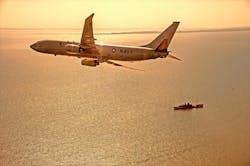Navy, Boeing expanding project to equip P-8A Poseidon maritime patrol aircraft with LRASM anti-ship missile
PATUXENT RIVER NAS, Md. – U.S. Navy aerial warfare experts are moving forward with a project to hire the Boeing Co. to integrate the Lockheed Martin Long Range Anti-Ship Missile (LRASM) onto early versions of Navy Boeing P-8A Poseidon maritime patrol aircraft.
Officials of the Naval Air Systems Command at Patuxent River Naval Air Station, Md., announced their intention last week to award a sole-source contract to the Boeing Defense, Space & Security segment in Seattle to provide hardware and software for LRASM mission planning for early configurations of P-8A fleet aircraft -- a militarized version of the Boeing 737-800ERX single-aisle passenger jet.
The LRASM is a joint project of the U.S. Defense Advanced Projects Agency (DARPA) in Arlington, Va., the Navy, and the Air Force for launch from the Navy F/A-18E/F Super Hornet jet fighter bomber, as well as from the Air Force B-1B Lancer long-range strategic bomber.
The upcoming two-year contract to Boeing, which should be awarded this spring, includes engineering and instrumentation support to LRASM airworthiness testing. The value of the contract has yet to be negotiated.
In the future LRASM also will launch from the F-35 Lighting II joint strike fighter, as well as from the Navy Mark 41 shipboard Vertical Launch System. Submarine-launched versions are under consideration.
Last April Boeing won a $74 million order to integrate the LRASM onto later versions of the P-8A maritime patrol aircraft. The Navy also is interested in fitting the Poseidon aircraft with 500-to-2,000-pound versions of the Joint Direct Attack Munition (JDAM); MK 62, 63, and 65 mines; Small Diameter Bomb (SDB-II); Miniature Air Launched Decoy (MALD); Bomb Rack Unit BRU-55; and Universal Armament Interface (UAI).
LRASM is designed to detect and destroy high-priority targets within groups of ships from extended ranges in electronic warfare jamming environments. It is a precision-guided, anti-ship standoff missile based on the Lockheed Martin Joint Air-to-Surface Standoff Missile-Extended Range (JASSM-ER).
LRASM is to replace the ageing Harpoon anti-ship missile, and has a multi-mode radio frequency sensor, a new weapon data-link and altimeter, and an uprated power system.
The LRASM can be guided toward enemy ships from as far away as 200 nautical miles by its launch aircraft, can receive updates via its datalink, or can use onboard sensors to find its target. LRASM will fly towards its target at medium altitude then drop to low altitude for a sea skimming approach to counter shipboard anti-missile defenses. Lockheed Martin is in charge of LRASM overall development, and the BAE Systems Electronic Systems segment in Nashua, N.H., is developing the LRASM onboard sensor systems.
For more information contact Boeing Defense, Space & Security online at www.boeing.com, or Naval Air Systems Command at www.navair.navy.mil.
About the Author
John Keller
Editor-in-Chief
John Keller is the Editor-in-Chief, Military & Aerospace Electronics Magazine--provides extensive coverage and analysis of enabling electronics and optoelectronic technologies in military, space and commercial aviation applications. John has been a member of the Military & Aerospace Electronics staff since 1989 and chief editor since 1995.
